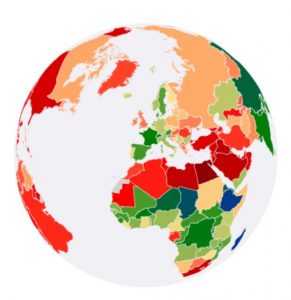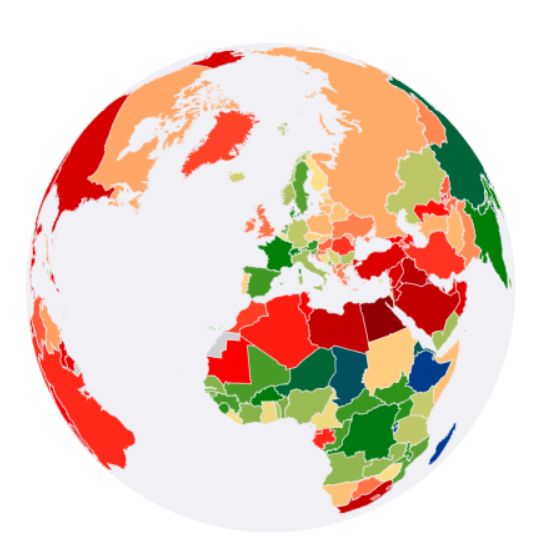
Professor Cyrus Cooper, Professor of Rheumatology at the MRC Lifecourse Epidemiology Centre, University of Southampton, has co-authored a landmark report documenting the current global burden of obesity.
The Lancet: More than one billion people in the world are now living with obesity, global analysis suggests
- Obesity rates among children and adolescents worldwide increased four times from 1990 to 2022, while obesity rates among adults have more than doubled.
- Over the same period, rates of underweight fell among children, adolescents and adults, leading to obesity becoming the most common form of malnutrition in many countries.
- Countries with the highest combined rates of underweight and obesity in 2022 were island nations in the Pacific and the Caribbean and countries in the Middle East and North Africa.
- The study highlights an urgent need for major changes to measures aimed at tackling obesity, as well as policies to further reduce the number of people who are underweight, especially in the poorest parts of the world.
The total number of children, adolescents and adults worldwide living with obesity has surpassed one billion, according to a global analysis published in The Lancet. These trends, together with the declining prevalence of people who are underweight since 1990, make obesity the most common form of malnutrition in most countries.
The analysis of global data estimates that among the world’s children and adolescents, the rate of obesity in 2022 was four times the rate in 1990. Among adults, the obesity rate more than doubled in women and nearly tripled in men. In total, 159 million children and adolescents and 879 million adults were living with obesity in 2022.
Between 1990 and 2022, the proportion of the world’s children and adolescents who were affected by underweight fell by around one fifth in girls and more than one third in boys. The proportion of the world’s adults who were affected by underweight more than halved over the same period.
Obesity and underweight are both forms of malnutrition and are detrimental to people’s health in many ways. This latest study provides a highly detailed picture of global trends in both forms of malnutrition over the last 33 years.
“It is very concerning that the epidemic of obesity that was evident among adults in much of the world in 1990 is now mirrored in school-aged children and adolescents. At the same time, hundreds of millions are still affected by undernutrition, particularly in some of the poorest parts of the world. To successfully tackle both forms of malnutrition it is vital we significantly improve the availability and affordability of healthy, nutritious foods.”
Senior author Professor Majid Ezzati, of Imperial College London
The new study was conducted by the NCD Risk Factor Collaboration (NCD-RisC), in collaboration with the World Health Organization (WHO). Researchers analysed weight and height measurements from over 220 million people aged five years or older (63 million people aged five to 19 years, and 158 million aged 20 years or older), representing more than 190 countries. More than 1,500 researchers contributed to the study, which looked at body mass index (BMI) to understand how obesity and underweight have changed worldwide from 1990 to 2022.
Adults were classed as being affected by obesity if they had a BMI greater than or equal to 30kg/m2 and classed as underweight if their BMI was below 18.5kg/m2. Among school-aged children (aged five to nine years) and adolescents (aged 10-19 years), the BMI used to define obesity and underweight depended on age and sex because there is significant increase in height and weight during childhood and adolescence [1].
From 1990 to 2022, global obesity rates more than quadrupled in girls (1.7% to 6.9%) and boys (2.1% to 9.3%), with increases seen in almost all countries. The proportion of girls who were underweight fell from 10.3% in 1990 to 8.2% in 2022, and for boys it fell from 16.7% to 10.8%. Among girls, a decrease in the rates of underweight was detected in 44 countries, whilst among boys, a decrease was noted in 80 countries.
The total number of children and adolescents who were affected by obesity in 2022 was nearly 160 million (65 million girls and 94 million boys), compared to 31 million in 1990. Whereas 77 million girls and 108 million boys were underweight in 2022, decreasing from 81 million for girls and 138 million for boys in 1990.
In adults, obesity rates more than doubled among women (8.8% to 18.5%) and nearly tripled in men (4.8% to 14.0%) between 1990 and 2022. The proportion of adults who were underweight halved between 1990 and 2022 (14.5% to 7.0% in women; 13.7% to 6.2% in men).
In total, an estimated nearly 880 million adults were living with obesity in 2022 (504 million women and 374 million men), four and a half times the 195 million recorded in 1990 (128 million women and 67 million men). Combined with the 159 million children living with obesity in 2022, this is a total of over one billion people affected by obesity in 2022. Despite global population growth, 183 million women and 164 million men were affected by underweight in 2022, 45 million and 48 million fewer, respectively, than in 1990.
Overall, these trends have led to a transition where in most countries, a larger number of people are affected by obesity than underweight. In 2022 obesity rates were higher than rates of underweight for girls and boys in around two thirds of the world’s countries (133 countries for girls and 125 countries for boys).
“This new study highlights the importance of preventing and managing obesity from early life to adulthood, through diet, physical activity, and adequate care, as needed. Getting back on track to meet the global targets for curbing obesity will take the work of governments and communities, supported by evidence-based policies from WHO and national public health agencies. Importantly, it requires the cooperation of the private sector, which must be accountable for the health impacts of their products.”
Dr Tedros Adhanom Ghebreyesus, WHO Director-General.
In all age groups, the combined burden of both forms of malnutrition increased in most countries between 1990 and 2022, driven by increasing obesity rates. However, the double burden of malnutrition declined in many countries in South and Southeast Asia, and in some countries in Africa for men, where the rate of underweight fell steeply.
“The impact of issues such as climate change, disruptions caused by the COVID-19 pandemic, and the war in Ukraine risk worsening both rates of obesity and underweight, by increasing poverty and the cost of nutrient-rich foods. The knock-on effects of this are insufficient food in some countries and households and shifts to less healthy foods in others. To create a healthier world, we need comprehensive policies to address these challenges.”
Dr. Guha Pradeepa, study co-author from the Madras Diabetes Research Foundation, warns that major global issues risk worsening both forms of malnutrition
The rise in double burden has been greatest in some low-income and middle-income countries, particularly those in Polynesia and Micronesia, the Caribbean, and the Middle East and North Africa. These countries now have higher obesity rates than many high-income industrialised countries, especially those in Europe.
Regional/country data for adults
Countries with the highest prevalence of obesity in 2022 were the island nations of Tonga and American Samoa for women and American Samoa and Nauru for men in Polynesia and Micronesia, where more than 60% of the adult population were living with obesity.
In the UK, the obesity rate increased from 13.8% in 1990 to 28.3% in 2022 for women and 10.7% to 26.9% in 2022 for men. The prevalence of obesity in the UK ranked 87th highest in the world for women and 55th highest in the world for men in 2022.
In the USA, the obesity rate increased from 21.2% in 1990 to 43.8% in 2022 for women and 16.9% to 41.6% in 2022 for men. The prevalence of obesity in the USA ranked 36th highest in the world for women and 10th highest in the world for men in 2022.
In China, the obesity rate increased from 2.0% in 1990 to 7.8% in 2022 for women and 0.8% to 8.9% in 2022 for men. The prevalence of obesity in China ranked 11th lowest (190th highest) in the world for women and 52nd lowest (149th highest) in the world for men in 2022.
In India, the obesity rate increased from 1.2% in 1990 to 9.8% in 2022 for women and 0.5% to 5.4% in 2022 for men. The prevalence of obesity in India ranked 19th lowest (182nd highest) in the world for women and 21st lowest (180th highest) in the world for men in 2022.
Countries with the highest prevalence of underweight in 2022 were Eritrea and Timor-Leste for women and Eritrea and Ethiopia for men, where more than 20% of the adult population were affected by underweight.
In China, the underweight rate decreased from 11.2% in 1990 to 5.9% in 2022 for women and 9.5% to 2.9% in 2022 for men. The prevalence of underweight in China ranked 61st highest in the world for women and 97th highest in the world for men in 2022.
In India, the underweight rate decreased from 41.7% in 1990 to 13.7% in 2022 for women and 39.8% to 12.5% in 2022 for men. The prevalence of underweight in India ranked 13th highest in the world for women and 26th highest in the world for men in 2022.
Regional/country data for children and adolescents
Countries with the highest prevalence of obesity in 2022 were Niue and Cook Islands for both girls and boys, where more than 30% of the child and adolescent population were living with obesity.
In the UK, the obesity rate increased from 4.7% in 1990 to 10.1% in 2022 for girls and 4.3% to 12.4% in 2022 for boys. The prevalence of obesity in the UK ranked 72nd highest in the world for girls and 91st highest in the world for boys in 2022.
In the USA, the obesity rate increased from 11.6% in 1990 to 19.4% in 2022 for girls and 11.5% to 21.7% in 2022 for boys. The prevalence of obesity in the UK ranked 22nd highest in the world for girls and 26th highest in the world for boys in 2022.
In China, the obesity rate increased from 0.6% in 1990 to 7.7% in 2022 for girls and 1.3% to 15.2% in 2022 for boys. The prevalence of obesity in China ranked 99th lowest (102nd highest) in the world for girls and 70th highest in the world for boys in 2022.
In India, the obesity rate increased from 0.1% in 1990 to 3.1% in 2022 for girls and 0.1% to 3.9% in 2022 for boys. The prevalence of obesity in India ranked 27th lowest (174th highest) in the world for both girls and boys in 2022.
Countries with the highest prevalence of underweight in 2022 were India and Sri Lanka for girls and Niger and India for boys, where more than 15% of the child and adolescent population were living with obesity.
In China, the underweight rate decreased from 5.8% in 1990 to 3.3% in 2022 for girls and 6.8% to 4.0% in 2022 for boys. The prevalence of underweight in China ranked 93rd highest in the world for girls and 89th lowest (112th highest) in the world for boys in 2022.
In India, the underweight rate decreased from 27.3% in 1990 to 20.3% in 2022 for girls and 45.1% to 21.7% in 2022 for boys. The prevalence of underweight in India ranked highest in the world for girls and 2nd highest in the world for boys in 2022.
The authors acknowledge some limitations to their study. While BMI is an imperfect measure of the extent and distribution of body fat, it is widely recorded in population-based surveys, making analyses such as these possible. Some countries had little data and three had no studies, meaning their estimates are more uncertain. There were also differences in data availability by age group, with fewer data available for those aged five to nine years, and people aged over 65 years, increasing the uncertainty of estimates for these age groups.
NOTES
This study was funded by UK Medical Research Council, UK Research and Innovation, and the European Commission. It was conducted by researchers from the NCD Risk Factor Collaboration (NCD-RisC), a worldwide network of over 1,500 researchers and practitioners that provides rigorous and timely information on NCD risk factors for all countries. NCD-RisC is coordinated by the WHO Collaborating Centre on NCD Surveillance, Epidemiology and Modelling at Imperial College London, and collaborates with the World Health Organization (WHO) on the work.
The labels have been added to this press release as part of a project run by the Academy of Medical Sciences seeking to improve the communication of evidence. For more information, please see: http://www.sciencemediacentre.org/wp-content/uploads/2018/01/AMS-press-release-labelling-system-GUIDANCE.pdf if you have any questions or feedback, please contact The Lancet press office pressoffice@lancet.com
Quotes from Authors cannot be found in the text of the Article but have been supplied for the press release.
[1] https://www.who.int/tools/growth-reference-data-for-5to19-years/indicators/bmi-for-age
Data
• Adults: https://www.ncdrisc.org/data-downloads-adiposity.html
• School-aged children and adolescents: https://www.ncdrisc.org/data-downloads-adiposity-ado.html
Visualisations:
• Adults: https://www.ncdrisc.org/data-visualisations-adiposity.html
• School-aged children and adolescents: https://www.ncdrisc.org/data-visualisations-adiposity-ado.html
Country fact sheets for all countries:
• https://www.ncdrisc.org/country-profile.htm
For interviews with the Article author, please contact: Ryan O’Hare, Media Manager (Medicine), Imperial College London E) r.ohare@imperial.ac.uk T) +44 (0)20 7594 2410








